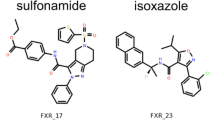Abstract
Computer assisted drug design (CADD) is a process involving the execution of many computer programs, ensuring that the ligand binds optimally to its receptor. This process is usually executed using shell scripts which input parameters assignments and result analyses are complex and time consuming. Moreover, receptors and ligands are naturally flexible molecules. In order to explicitly model the receptor flexibility during molecular docking experiments, we propose to use different receptor conformations derived from a molecular dynamics simulation trajectory. This work presents an integrated scientific workflow solution aiming at automating molecular docking with explicit inclusion of receptor flexibility. Enhydra JAWE and Shark software tools were used to model and execute workflows, respectively. To test our approach we performed docking experiments with the M. tuberculosis enzyme InhA (receptor) and three ligands: NADH, IPCF and TCL. The results illustrate the effectiveness of both the proposed workflow and the implementation of the docking processes.
Preview
Unable to display preview. Download preview PDF.
Similar content being viewed by others
References
Luscombe, N.M., Greenbaum, D., Gerstein, M.: What is Bioinformatics? A Proposed Definition and Overview of the Field. Meth. Inform. Med. 4, 346–358 (2001)
Chagoyen, M., Kurul, M.E., De-Alarcón, P.A., Carazo, J.M., Gupta, A.: Designing and Executing Scientific Workflows with a programmable integrator. Bioinformatics 20, 2092–2100 (2004)
Wainer, J., Weske, G.V., Medeiros, C.B.: Scientific Workflow Systems. In: Proceedings of the NFS Workshop on Workflow and Process Automation in Information Systems: State-of-the-art and Future Directions, Athens, Georgia, USA (1996)
Goodsell, D.S., Olson, A.J.: Automated docking of substrates to proteins by simulated annealing. Proteins 8, 195–202 (1990)
Carlson, H.A.: Protein flexibility is an important component of structure-based drug discovery. Curr. Pharm. Des. 8, 1571–1578 (2002)
Mehta, N., Barter, R.H.: Design Document for JAWE2Openflow Project 2004 (accessed in December 2005), available in http://forge.objectweb.org/projects/jawe/
Enhydra Shark (accessed in December 2005), available in http://forge.objectweb.org/projects/shark/
Case, D.A., Pearlman, D.A., Caldwell, J.W., Cheathem III, T.E., Ross, W.R., Simmerling, C.L., Darden, T.A., Merz, K.M., Stanton, R.V., Cheng, A.L., Vincent, J.J., Crowley, M., Tsui, V., Radmer, R.J., Duan, Y., Pitera, J., Massova, I., Seibel, G.L., Singh, U.C., Weiner, P.K., Kollman, P.A.: AMBER 6.0. University of California, San Francisco (1999)
Drews, J.: Drug discovery: A historical perspective computational methods for biomolecular docking. Curr. Opin. Struct. Biol. 6, 402–406 (1996)
Kuntz, I.D.: Structure-based strategies for drug design and discovery. Science 257, 1078–1082 (1992)
Schroeder, E.K., Basso, L.A., Santos, D.S., Norberto de Souza, O.: Molecular Dynamics Simulation Studies of the Wild-Type, I21V, and I16T Mutants of Isoniazid-Resistant Mycobacterium tuberculosis Enoyl Reductase (InhA) in Complex with NADH: Toward the Understanding of NADH-InhA Different Affinities. Biophys. J. 89, 876–884 (2005)
Lin, J-H., Perryman, A.L., Schames, J.R., McCammon, J.A.: Computational drug design accommodating receptor flexibility: the relaxed complex scheme. J. Am. Chem. Soc. 124, 5632–5633 (2002)
Sali, A.: 100.000 Protein Structures for the Biologist. Nat. Struct. Biol. 5, 1029–1032 (1998)
van Gunsteren, W.F., Berendsen, H.J.C.: Computer Simulation of Molecular Dynamics Methodology, Aplications and Perspectives in Chemistry. Angew. Chem. Int. Ed. Engl. 29, 992–1023 (1990)
Dessen, A., Quémard, A., Blanchard, J.S., Jacobs Jr., W.R., Sacchettini, J.C.: Crystal structure and function of the isoniazid target of Mycobacterium tuberculosis. Science 267, 1638–1641 (1995)
Workflow Management Coalition – Terminology & Glossary: Document number WFMC-TC-1011. Document Status- Issue 3.0 (1999) (accessed in March 2006), available in http://www.wfmc.org/standards/docs/TC-1011_term_glossary_v3.pdf
Ludäscher, B., Altintas, I., Berkley, C., Higgins, D., Jaeger, E., Jones, M.A., Lee, J., Tao, Y., Zhao, Y.: Scientific Workflow Management and the Kepler System. Concurrency and Computat.: Pract. Exper. 18, 1039–1065 (2005)
Weske, M., Vossen, G., Medeiros, C.: Scientific Workflow Management: WASA Architecture and Applications. In: Revell, N., Tjoa, A.M. (eds.) DEXA 1995. LNCS, vol. 978, Springer, Heidelberg (1995)
Kua, J., Zhang, Y., McCammon, A.: Studying Enzime Binding Specificity in Acetylcholinesterase Using a Combined Molecular Dynamics and Multiple Docking Approach. J. Am. Chem. Soc. 124, 8260–8267 (2002)
Berman, H.M., Westbrook, J., Feng, Z., Gilliland, G., Bhat, T.N., Weissig, H., Shindyalov, I.N., Bourne, P.E.: PDB - Protein Data Bank. Nucl. Acids Res. 28, 235–242 (2000)
Guex, N., Peitsch, M.C.: SWISS-MODEL and the Swiss-PdbViewer: An environment for comparative protein modeling. Electrophoresis 18, 2714–2723 (1997)
Chemical Computing Group, Inc. Montreal, Quebec, Canada. Molecular Operating Environment (MOE 2004.03) (accessed in July 2006), available in http://www.chemcomp.com
Oliveira, J.S., Sousa, E.H.S., Basso, L.A., Palaci, M., Dietze, R., Santos, D.S., Moreira, I.S.: An inorganic iron complex that inhibits wild-type and an isoniazid-resistant mutant 2-trans-enoyl-ACP (CoA) reductase from Mycobacterium tuberculosis. Chem. Comm. 3, 312–313 (2004)
Kuo, M.R., Morbidoni, H.R., Alland, D., Sneddon, S.F., Gourlie, B.B., Staveski, M.M., Leonard, M., Gregory, J.S., Janjigian, A.D., Yee, C., Musser, J.M., Kreiswirth, B., Iwamoto, H., Perozzo, R., Jacobs Jr., W.R., Sacchettini, J.C., Fodock, D.A.: Targeting tuberculosis and malaria through inhibition of enoyl reductase: compound activity and structural data. J. Biol. Chem. 278, 20851–20859 (2003)
Rozwarski, D.A., Grant, G.A., Barton, D.H., Jacobs Jr., W.R., Sacchettini, J.C.: Modification of the NADH of the isoniazid target (InhA) from Mycobacterium tuberculosis. Science 279, 98–102 (1998)
Author information
Authors and Affiliations
Editor information
Rights and permissions
Copyright information
© 2007 Springer-Verlag Berlin Heidelberg
About this paper
Cite this paper
Machado, K.S., Schroeder, E.K., Ruiz, D.D., Norberto de Souza, O. (2007). Automating Molecular Docking with Explicit Receptor Flexibility Using Scientific Workflows. In: Sagot, MF., Walter, M.E.M.T. (eds) Advances in Bioinformatics and Computational Biology. BSB 2007. Lecture Notes in Computer Science(), vol 4643. Springer, Berlin, Heidelberg. https://doi.org/10.1007/978-3-540-73731-5_1
Download citation
DOI: https://doi.org/10.1007/978-3-540-73731-5_1
Publisher Name: Springer, Berlin, Heidelberg
Print ISBN: 978-3-540-73730-8
Online ISBN: 978-3-540-73731-5
eBook Packages: Computer ScienceComputer Science (R0)




